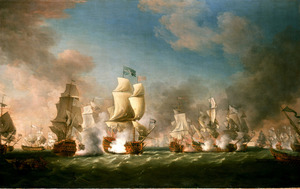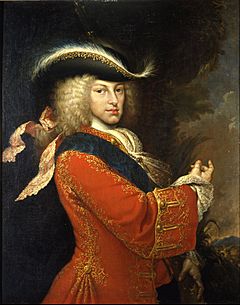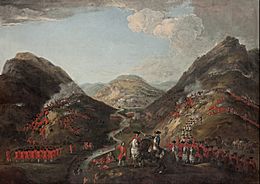War of the Quadruple Alliance facts for kids
Quick facts for kids War of the Quadruple Alliance |
|||||||||
|---|---|---|---|---|---|---|---|---|---|
 The Battle of Cape Passaro, 11 August 1718, Richard Paton |
|||||||||
|
|||||||||
| Belligerents | |||||||||
| Commanders and leaders | |||||||||
| Richard Temple George Byng James Fitzjames Claude de Mercy |
Jean de Bette José de Albornoz Antonio Gaztañeta George Camocke |
||||||||
The War of the Quadruple Alliance was a conflict that took place from 1718 to 1720. It started because Spain wanted to get back lands in Italy that it had lost in 1713. The main fighting happened in Sicily. There were also smaller battles in North America and Northern Europe. Spain also supported a rebellion in Scotland.
In 1717, Spain took back Sardinia from Austria easily. Then, in July 1718, Spain landed troops in Sicily. On August 2, 1718, four powerful countries formed an alliance. These were Britain, France, Austria, and the Dutch Republic. This group was called the Quadruple Alliance. The war ended in 1720 with the Treaty of The Hague. This treaty mostly put things back as they were before 1717. However, Savoy and Austria traded Sardinia and Sicily.
Contents
Why the War Started

After 1714, Spain quickly became strong again. This was thanks to new plans by chief minister Giulio Alberoni. He was supported by Elisabeth Farnese, who became King Philip V's second wife in 1714. In 1713, Spain had given up its lands in Italy and Flanders to Austria and Savoy. Getting these lands back was very important to King Philip V.
The previous war (1701-1714) made sure that France or Austria could not unite with Spain. But Philip V now questioned if he really gave up his claim to the French throne. Charles VI of Austria also did not fully agree to this rule. In late 1716, Britain and France, who used to be enemies, became allies. They wanted to make sure the peace treaty was followed. In January 1717, these two countries and the Netherlands formed the Triple Alliance.
The alliance wanted Charles VI and Philip V to confirm their claims to the French and Spanish thrones. They also wanted Savoy and Austria to trade Sicily and Sardinia. Spain did not see any benefit in this plan. So, Spain decided to try and take back the lands it had lost. Since neither Savoy nor Austria had strong navies, Spain targeted the islands of Sardinia and Sicily. This goal also fit with Elizabeth Farnese's family claims in Italy.
In August 1717, Spanish forces landed on Sardinia. By November, they had taken control of the island. They faced little resistance. Austria was busy fighting the Ottoman Empire. France and the Netherlands needed peace to rebuild their economies. Talks to solve the problem failed. In June 1718, a British navy force arrived in the Western Mediterranean. This was a warning to Spain. Spain felt confident after taking Sardinia. In July 1718, Spain landed 30,000 soldiers on Sicily. But the situation had changed. Austria signed a peace treaty with the Ottoman Empire in July 1718. On August 2, Austria joined Britain, France, and the Netherlands to form the Quadruple Alliance. This alliance gave the war its name.
The War Begins
The Spanish army took Palermo on July 7. Then they split their forces. On July 18, Marquess of Lede began to attack Messina. Meanwhile, the Duke of Montemar took over the rest of Sicily. On August 11, a British fleet led by Sir George Byng destroyed the Spanish fleet. This happened at the Battle of Cape Passaro.
Later that autumn, a small Austrian army landed near Messina. This army was put together in Naples by the Austrian Viceroy Count Wirich Philipp von Daun. They tried to stop the Spanish attack on Messina. But the Austrians were defeated in the First Battle of Milazzo on October 15. They only held a small area around Milazzo.
In 1718, Cardinal Alberoni started a secret plan. He wanted to replace the Duc d'Orléans, who was ruling France for the young King Louis XV of France. Alberoni wanted Philip V to rule France instead. This plan was called the Cellamare conspiracy. When the plan was found out, Alberoni was sent away from France. France then declared war on Spain. By December 17, 1718, France, Britain, and Austria had all officially joined the war against Spain. The Netherlands joined them later, in August 1719.
Fighting in Spain
The Duc d'Orléans ordered a French army to invade western Spain in April 1719. This army was led by the Duke of Berwick. Berwick successfully attacked San Sebastián. He also entered northern Catalonia. In both areas, some local leaders supported the French invaders. They even wanted these areas to become part of France. Spain tried to fight back by sending its own group to Brittany in France. They hoped to start a rebellion against the French ruler. This group had 1,000 soldiers and weapons for 10,000 more. But after landing at Vannes, they found little support and left.
Fighting in Sicily
In Sicily, the Austrians started a new attack. This was led by Count Claude Florimond de Mercy. They first lost a battle at Francavilla on June 20, 1719. But the Spanish army was cut off from Spain by the British fleet. It was only a matter of time before they would lose. Mercy then won the second Battle of Milazzo. He took Messina in October and then attacked Palermo.
Spanish Invasion of Britain
In 1719, an Irish exile named the Duke of Ormonde planned an invasion of Britain. He had strong support from Spain. The goal was to replace King George I with James Francis Edward Stuart, who was known as the "Old Pretender." But a storm near Galicia in 1719 scattered his fleet. It never reached Britain.
A small group of 300 Spanish marines did land near Eilean Donan. They were joined by Highlanders. But they were defeated at the Battle of Eilean Donan in May 1719. A month later, they lost again at the Battle of Glen Shiel. The hope for a rebellion quickly faded away.
British Attack on Vigo
To get back at Spain for this attack, the British government planned a raid on the Spanish coast. An expedition was put together at Portsmouth and the Isle of Wight. It was led by Lord Cobham and George Wade. They successfully captured Vigo and marched inland to Pontevedra in October 1719. This surprised the Spanish leaders. They realized how easily the Allies could attack their coast. This could open a new battlefront away from the French border.
Conflict in North America
The French captured the Spanish settlement of Pensacola in Florida in May 1719. This happened before a planned Spanish attack on South Carolina. Spanish forces took the town back in August 1719. But it fell to the French again later that year. The French destroyed the town before leaving.
A Spanish force of 1,200 men sailed from Cuba. Their goal was to take the British settlement of Nassau in the Bahamas. After taking a lot of valuable goods, they were eventually driven off by the local soldiers.
Peace Treaty
King Philip was not happy with how his kingdom was doing in the war. So, he fired Alberoni in December 1719. Philip then made peace with the allies by signing the Treaty of The Hague on February 17, 1720.
In the treaty, Philip had to give up all the land he had captured in the war. However, his third son was recognized as the future ruler of the Duchy of Parma and Piacenza. This would happen after the death of Elizabeth's uncle, Antonio Farnese, who had no children.
France returned Pensacola and the lands it had taken in northern Spain. In return, France received trade benefits. As part of this treaty, Victor Amadeus had to trade Sicily for the less important Kingdom of Sardinia.
What Happened After
This war was special because Britain and France were on the same side. This happened between 1716 and 1731, when the two countries were allies. Later, Spain would join with France in the Bourbon Compact. Then, Spain and France would become enemies of the British again.
Spain got back the Kingdom of Naples during the War of the Polish Succession (1733–1735).
See also
 In Spanish: Guerra de la Cuádruple Alianza para niños
In Spanish: Guerra de la Cuádruple Alianza para niños


